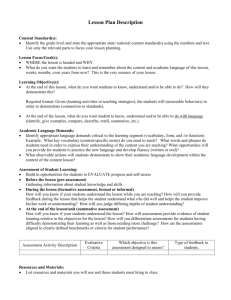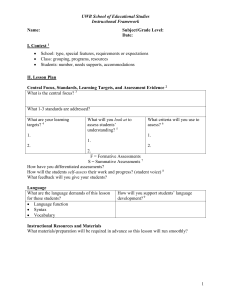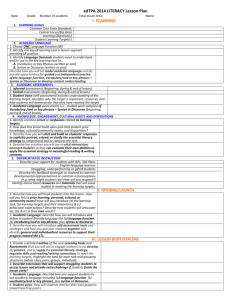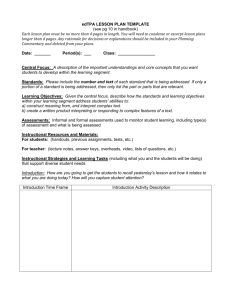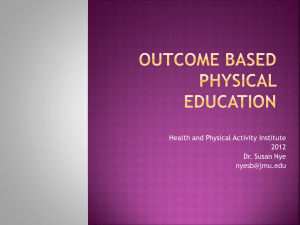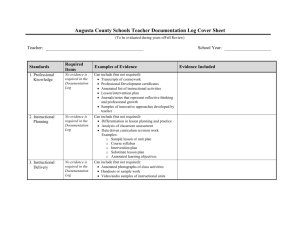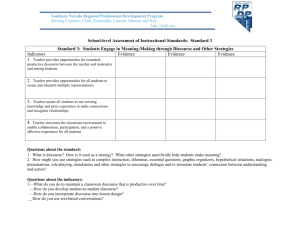Lesson Plan Template: Objectives, Assessment, Strategies
advertisement
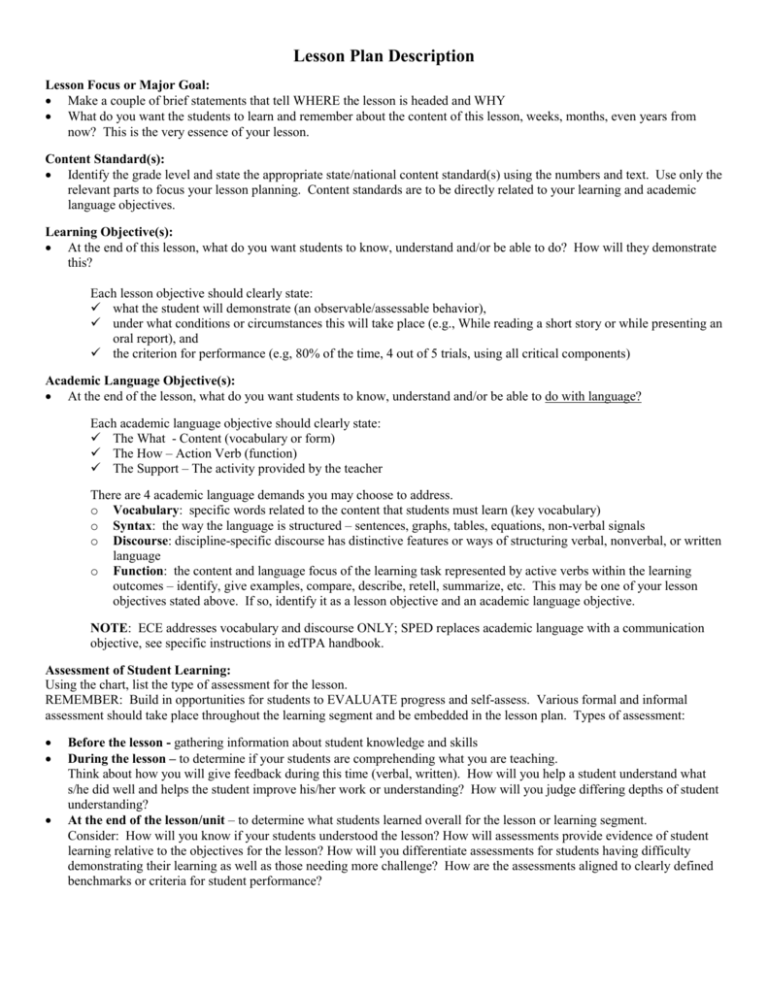
Lesson Plan Description Lesson Focus or Major Goal: Make a couple of brief statements that tell WHERE the lesson is headed and WHY What do you want the students to learn and remember about the content of this lesson, weeks, months, even years from now? This is the very essence of your lesson. Content Standard(s): Identify the grade level and state the appropriate state/national content standard(s) using the numbers and text. Use only the relevant parts to focus your lesson planning. Content standards are to be directly related to your learning and academic language objectives. Learning Objective(s): At the end of this lesson, what do you want students to know, understand and/or be able to do? How will they demonstrate this? Each lesson objective should clearly state: what the student will demonstrate (an observable/assessable behavior), under what conditions or circumstances this will take place (e.g., While reading a short story or while presenting an oral report), and the criterion for performance (e.g, 80% of the time, 4 out of 5 trials, using all critical components) Academic Language Objective(s): At the end of the lesson, what do you want students to know, understand and/or be able to do with language? Each academic language objective should clearly state: The What - Content (vocabulary or form) The How – Action Verb (function) The Support – The activity provided by the teacher There are 4 academic language demands you may choose to address. o Vocabulary: specific words related to the content that students must learn (key vocabulary) o Syntax: the way the language is structured – sentences, graphs, tables, equations, non-verbal signals o Discourse: discipline-specific discourse has distinctive features or ways of structuring verbal, nonverbal, or written language o Function: the content and language focus of the learning task represented by active verbs within the learning outcomes – identify, give examples, compare, describe, retell, summarize, etc. This may be one of your lesson objectives stated above. If so, identify it as a lesson objective and an academic language objective. NOTE: ECE addresses vocabulary and discourse ONLY; SPED replaces academic language with a communication objective, see specific instructions in edTPA handbook. Assessment of Student Learning: Using the chart, list the type of assessment for the lesson. REMEMBER: Build in opportunities for students to EVALUATE progress and self-assess. Various formal and informal assessment should take place throughout the learning segment and be embedded in the lesson plan. Types of assessment: Before the lesson - gathering information about student knowledge and skills During the lesson – to determine if your students are comprehending what you are teaching. Think about how you will give feedback during this time (verbal, written). How will you help a student understand what s/he did well and helps the student improve his/her work or understanding? How will you judge differing depths of student understanding? At the end of the lesson/unit – to determine what students learned overall for the lesson or learning segment. Consider: How will you know if your students understood the lesson? How will assessments provide evidence of student learning relative to the objectives for the lesson? How will you differentiate assessments for students having difficulty demonstrating their learning as well as those needing more challenge? How are the assessments aligned to clearly defined benchmarks or criteria for student performance? Sample Assessment Table: Assessment Activity Scoring Guide /Evaluative Criteria Exit slip 4 out of 5 correct Informal questioning Teacher observation of correct responses – no formal criteria Graphic organizer Average score 3 on 4 point rubric with 5 elements Assesses which objective? Objective 1 Objective 3 Feedback type to students. Written Verbal Objective 2 Written Resources, Materials, and Technology: List resources, materials, and technology you will use to enhance instruction. Identify what students must bring to class. Lesson Introduction/Motivational Statement: HOOK students and HOLD their attention throughout the lesson This is the springboard into your lesson by focusing the students’ attention on what they will learn. How will you pique students’ interest? Use past learning, everyday examples, or life skills to anchor the lesson. How does this lesson connect to yesterday’s learning and why are you adding to this learning – where is this all going? Instructional Strategies and Planned Supports: In the left column, list the progression that the lesson will follow. Identify what you will be doing; describe the content you will be teaching, the methods you will use to support student learning of content and academic language, and the strategies to extend student thinking. List your critical thinking questions as well. Include the type of feedback you plan to give students (e.g., prompting, cueing, and correction techniques). Instructional Strategies and Planned Supports: Identify each learning task, (content and planned supports that show progression) that you will teach. Learning Tasks: Identify the progression of what learning activities students will be doing. How will they be organized for the task? Within each learning task, identify what planned support(s) you will provide. Consider each of the following: Planned supports for all learners. Planned support for academic language Scaffolds – how will you tie this to past lessons and/or prior knowledge? Structures – how will you model the academic language? Supports - How will you provide multiple opportunities for practicing/using the academic language? Planned support for differentiated instruction How will you use knowledge of students to differentiate instruction for different levels of ability and/or different levels of content knowledge? How will you use different strategies for learning and/or cultural and language differences? Consider the BEST instructional strategies and learning tasks that will maintain classroom management or order. Closure Activity: At the conclusion of the lesson, closure is the time to help the students organize the information that has been presented to aid their retention. Students should be involved in thinking and discussion of the lesson focus. Consider engaging them in a short review by posing questions. The students should be given a chance to personally reflect on the lesson, to share their ideas with others, and with the class as a whole. Reflection: Did students learn what you intended? How do you know; what is your evidence? How effective was your instruction? How do you know you were/not effective? What is working? What is not? What would you change? Identify one thing you could do to ensure student learning and why it would lead to improved student learning. Were your students successful? What is a possible reason(s) for their success or lack of success? What do you plan to do in the next lesson based on your reflection– what are your next steps?
